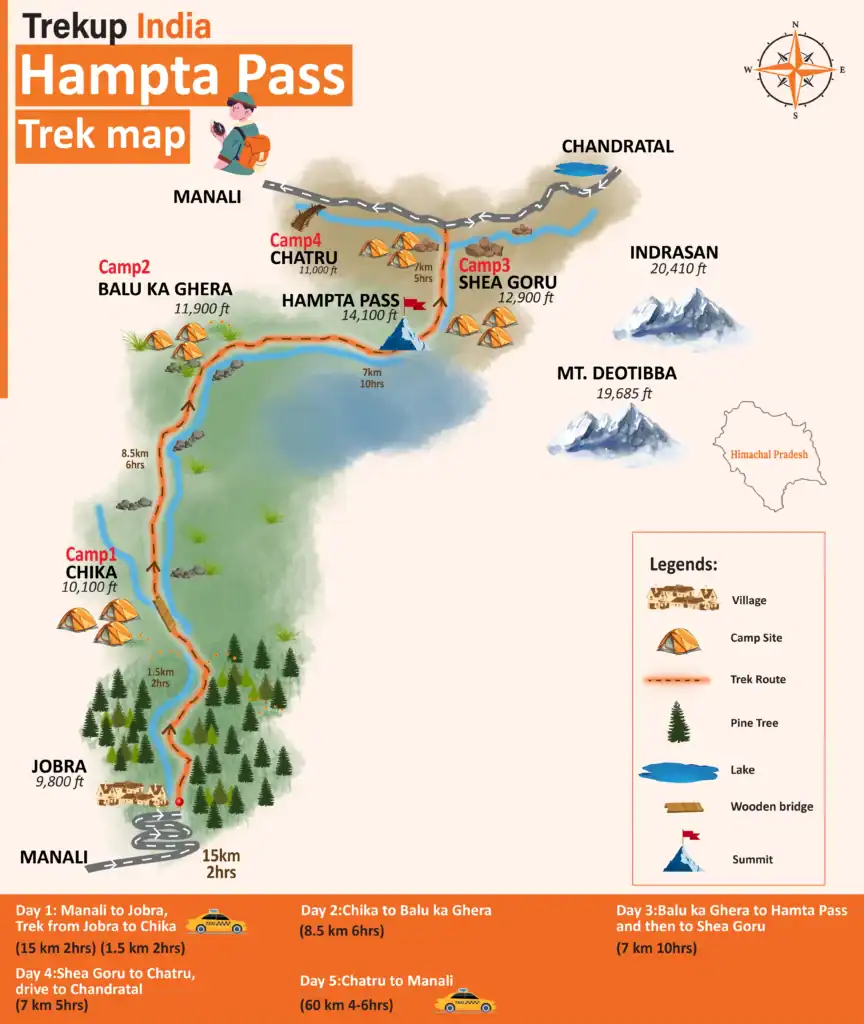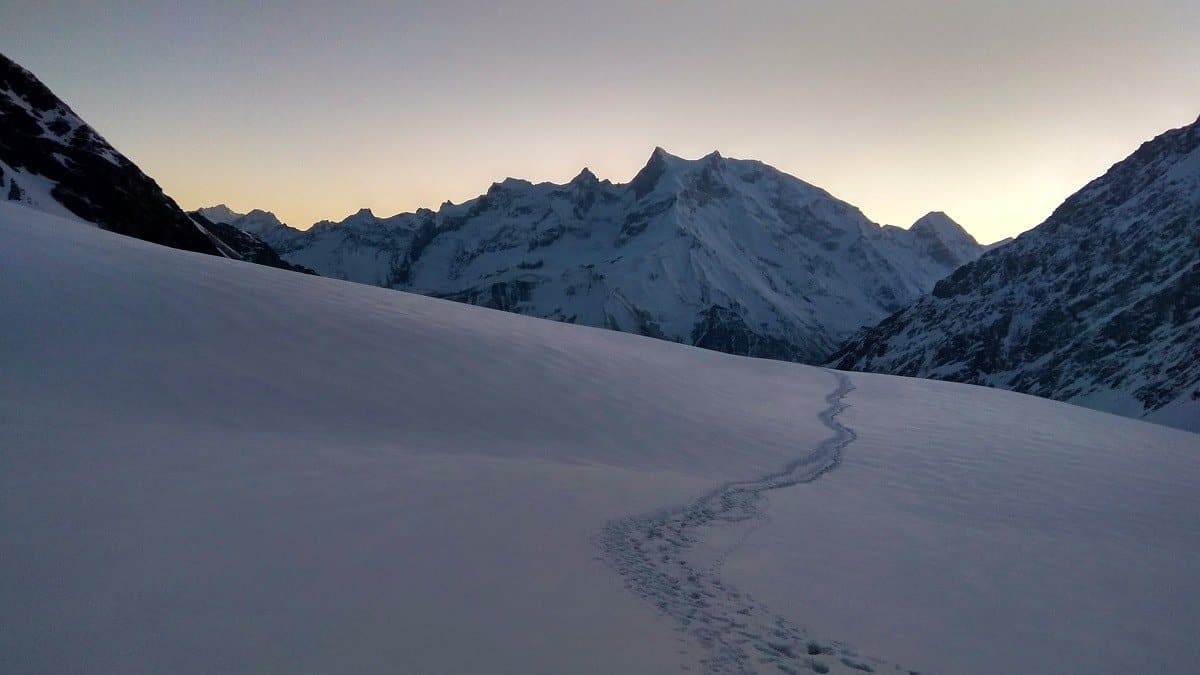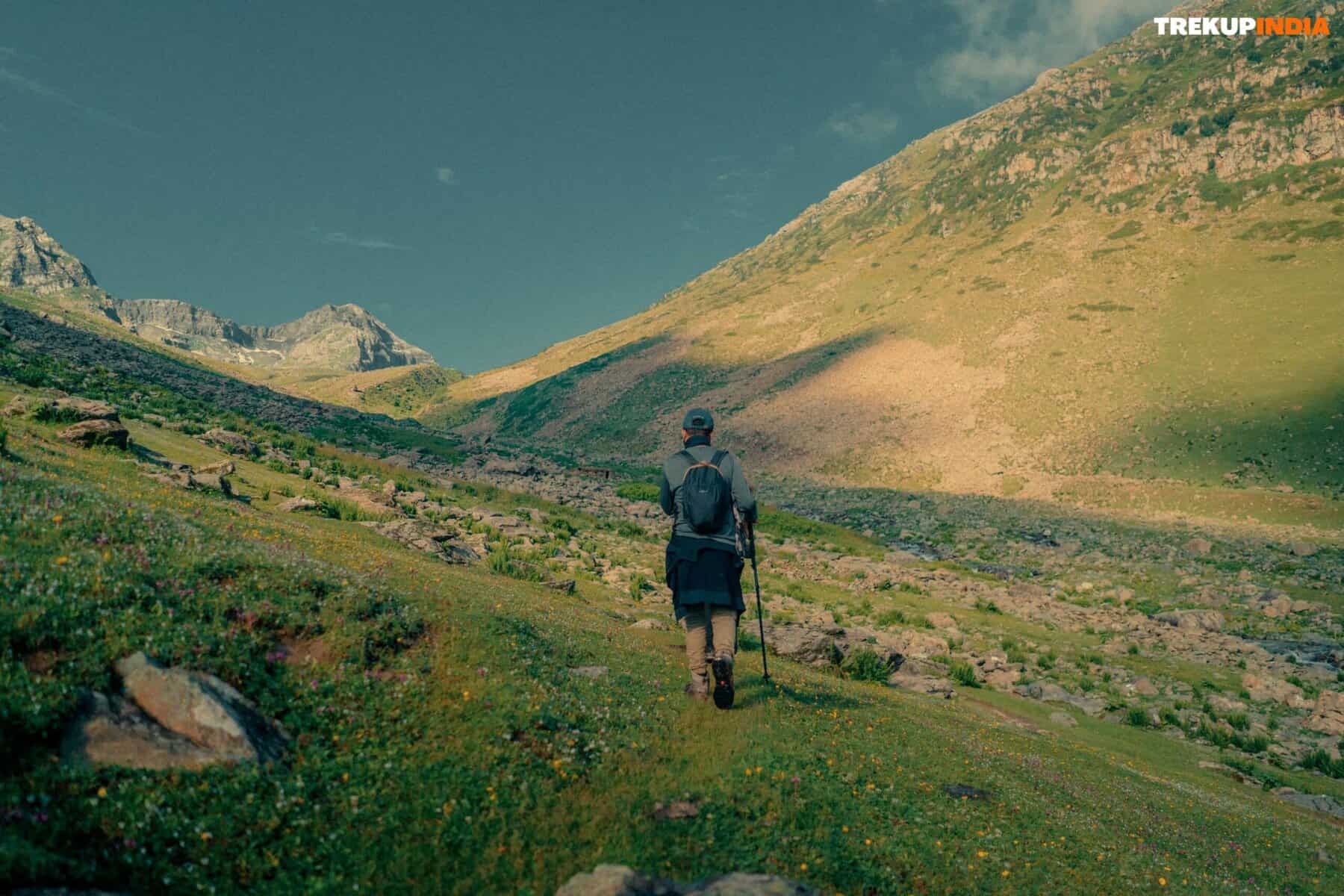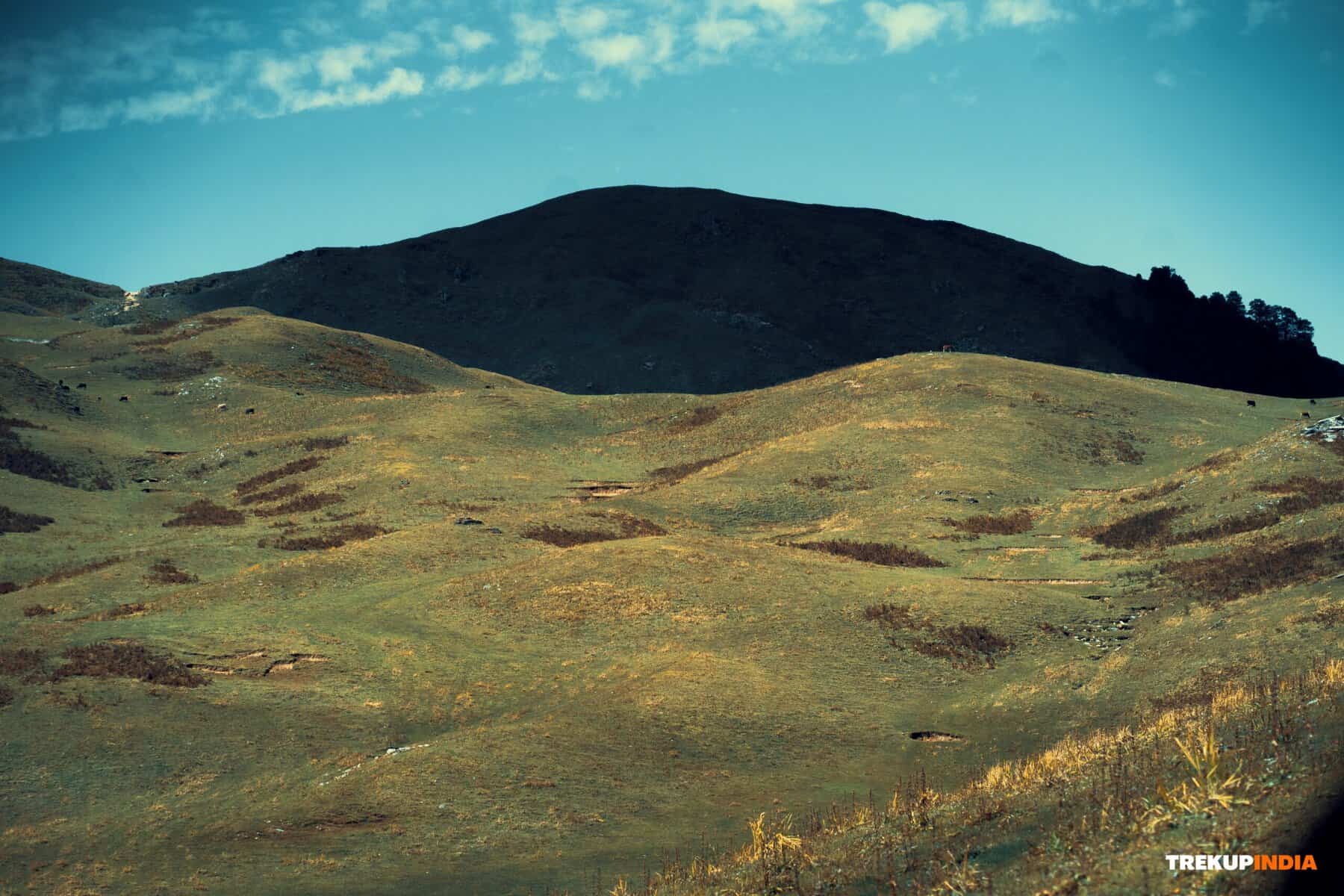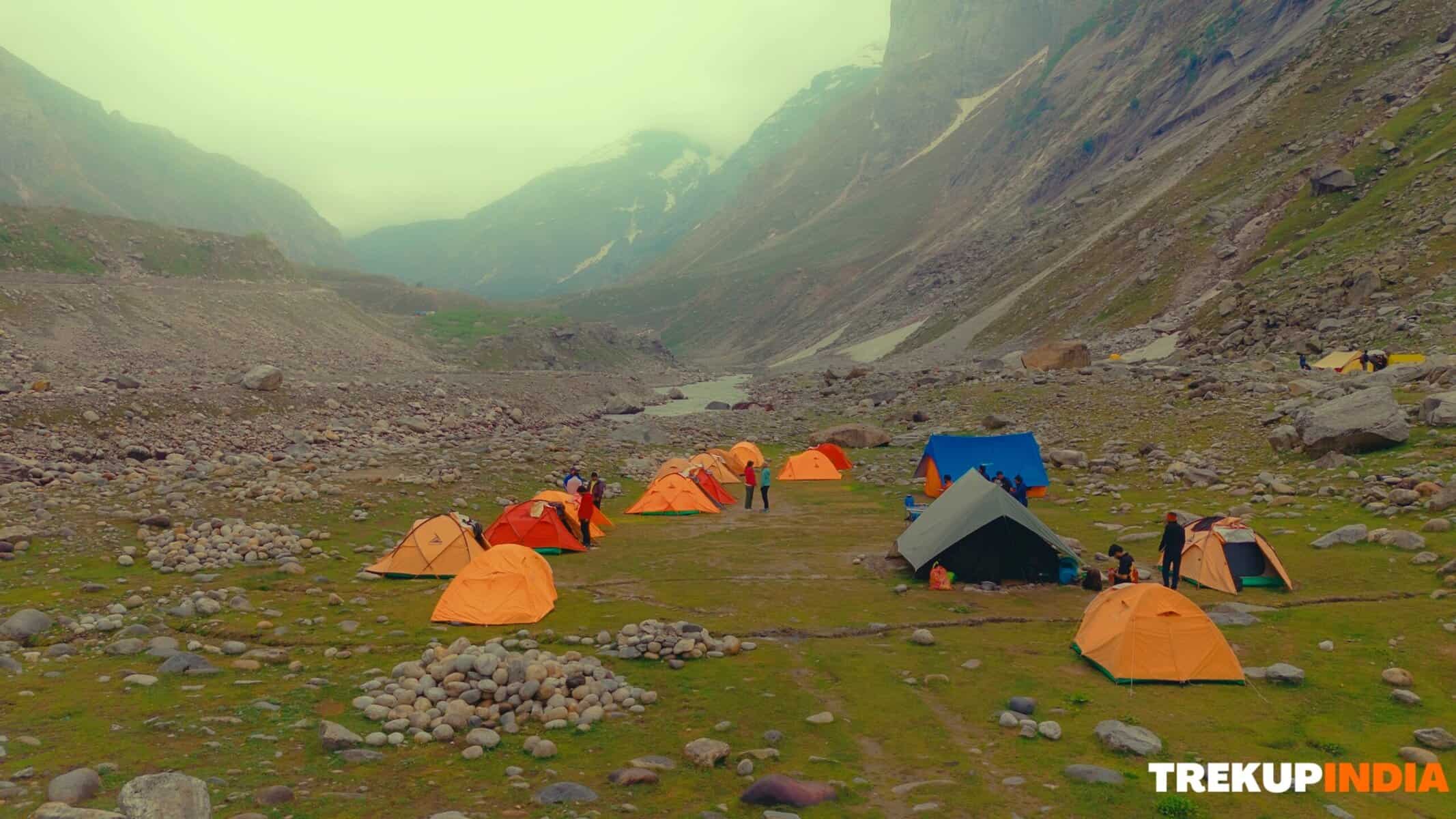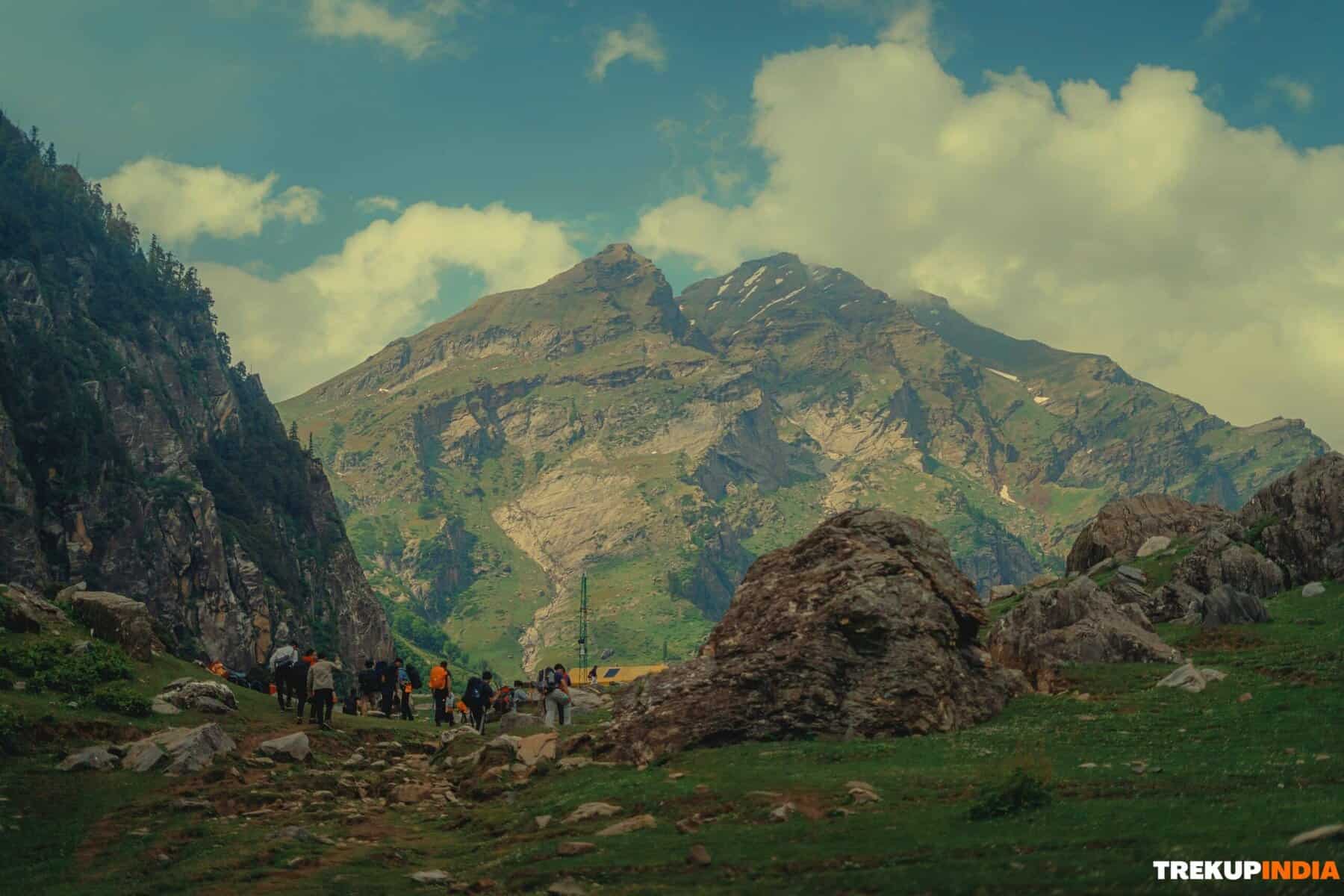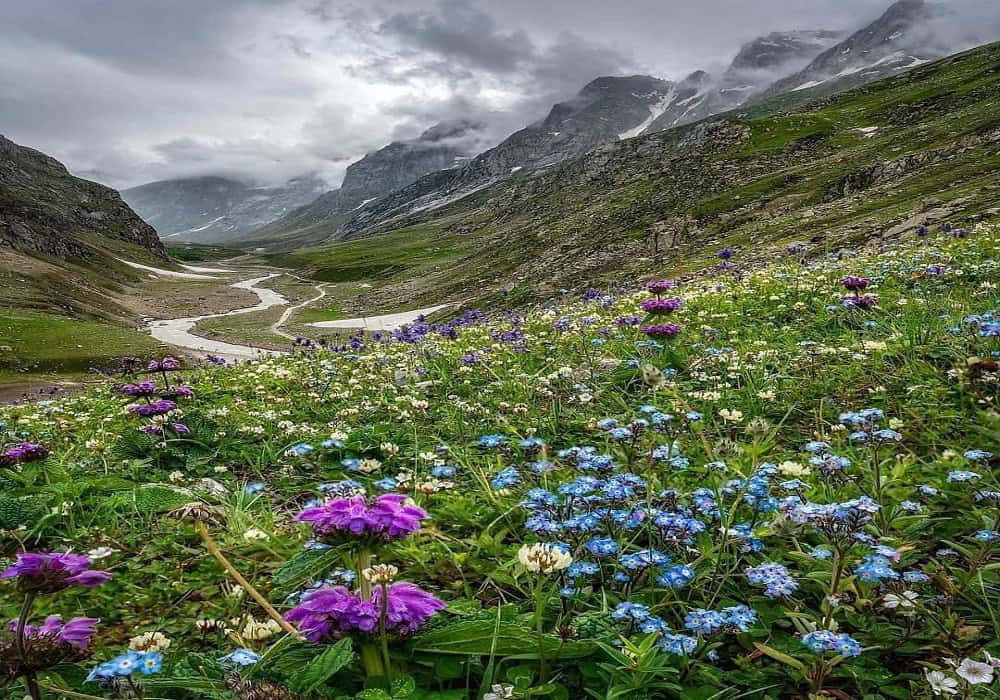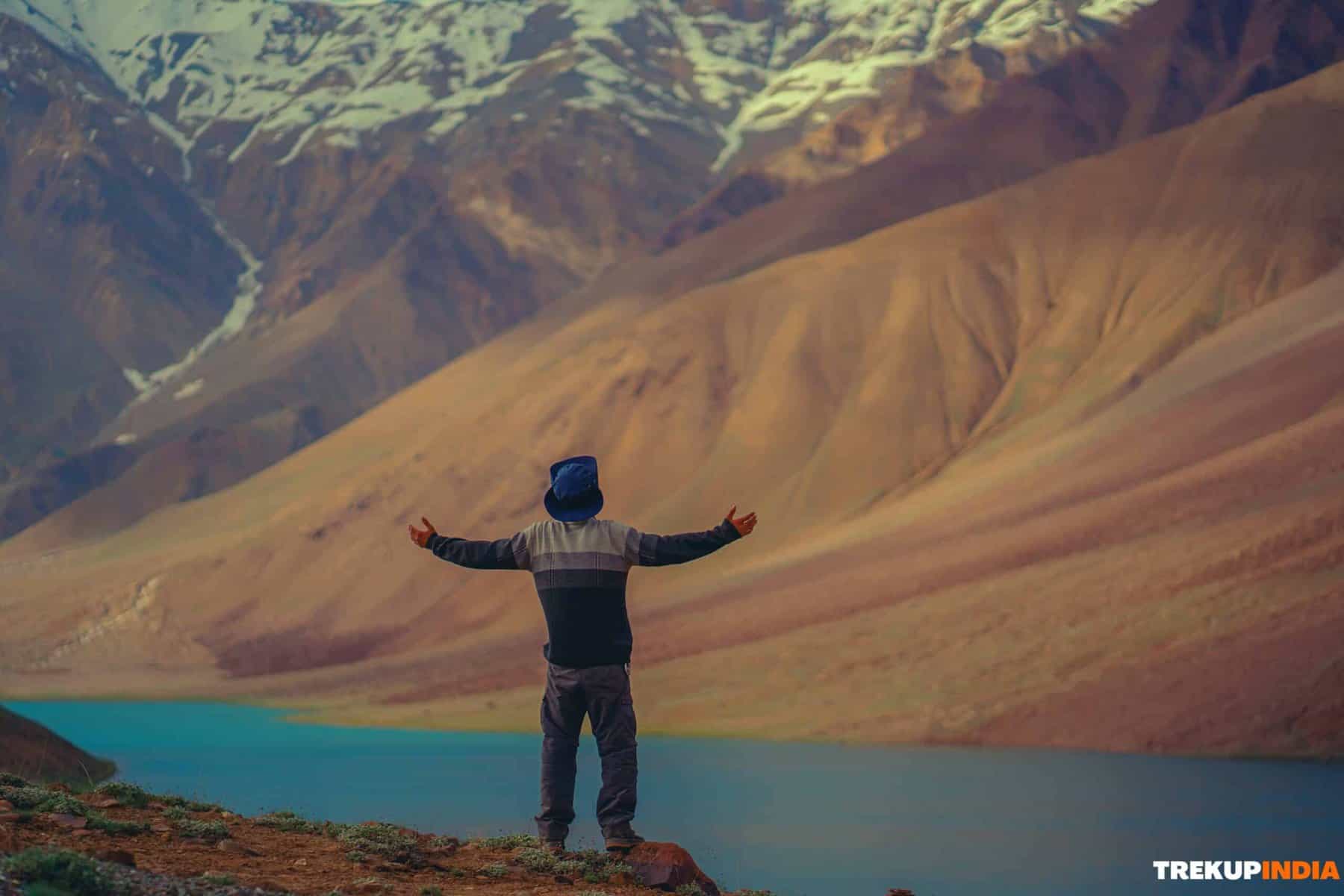Trek Grade
Easy - Moderate
Highest Altitude
14,000 ft
Base Camp
Manali
Best Time
June to Sept
Trek Distance
26 Km
Not sure which trek is right for you? Trekup India’s Mountain Experts have you covered.
Not sure which trek is right for you? Trekup India’s Mountain Experts have you covered. From figuring out if a trek matches your fitness level to knowing who you’ll be trekking with, we’re here to answer all your questions. Reach out to our Mountain Experts and plan your trek with confidence.
Hampta Pass Trek – The Ultimate Himalayan Crossover Adventure
Hampta Pass Trek offers an unforgettable adventure to trekkers at all levels. This high-altitude journey is known for its spectacular landscape changes. It connects the green Kullu Valley with the barren Spiti Valley. The result is a stunningly beautiful and emotional journey. The Hampta Pass Trek is a 26-kilometer trek that reaches a height of over 14,000 feet. It’s the perfect introduction to high altitude trekking in India.
Its ever-changing landscapes are the real attraction of the Hampta Pass Trek. The trail begins at Jobra, a small town in Manali. It takes you to dense forests with deodars, silver birches, and maples. The scenery changes as you ascend higher to campsites such as Chika, Balu Ka Ghera and Shea Goru. From forested trails to meadows full of wildflowers, to finally snow-covered slopes with barren rock walls, it all happens. The constant changes in landscape make the Hampta Pass Trek a journey every day.
The dramatic crossing at the pass is one of the highlights of the Hampta Pass Trek. You’ll be rewarded by breathtaking views as you climb to the top. These include deep valleys and glaciers far away. Close-up views of magnificent mountains such as Mt. Indrasan, Mt. This trek is a haven for photographers and mountain enthusiasts. Just when you thought you had seen everything, you descend to Lahaul’s cold desert and then the stunning blue waters of Chandratal Lake, a glacial lake hidden in the mountains high above the Spiti area. Chandratal Lake is a wonderful way to end an unforgettable trek.
The Hampta Pass Trek offers a moderate challenge, which is perfect for those with basic fitness and an adventurous spirit. One of the trek’s most thrilling elements is the river crossings–fast-flowing glacial streams you’ll cross with the help of ropes and support from trek leaders. The river crossings are a thrilling part of the trek, particularly between Chika and Balu Ka Ghera, and Shea Goru and Chatru. Along the trail, trekkers will also see Himalayan plants like Pink Hill Geranium and Blue Poppy.
The Hampta Pass Trek offers a variety of scenic campsites. These include the charming riverside village of Chika or the snow-covered valley of Balu Ka Ghera. The connection with nature is enhanced by sleeping under the stars, listening to the sounds of the rivers. Trekkers in June can expect to encounter snow in the upper reaches. Trekup India offers microspikes, gaiters and other safety gear for such weather conditions. In July and August the meadows are alive with wildflowers as the snow melts. The trail is incredibly picturesque.
From June to September, is the best time for you to complete the Hampta Pass Trek. Snow-covered paths are available in early June, while greenery and flowing streams can be found between July and August. The best time to visit is September, when you can enjoy clear skies, pleasant weather and warm nights. The Hampta Pass is a magical experience no matter when you decide to hike.
The Hampta Pass Trek is eco-sensitive, which makes it even more unique. Respecting the trail, carrying your waste and following sustainable trekking methods are essential. The role of the trek leader is crucial in helping to guide hikers safely. This is especially true when it comes to steep ascents or unpredictable weather.
The Hampta Pass Trek offers more than just an exciting hike. It’s also a fascinating cross-over between two worlds. This trek offers the full Himalayan experience, including deodar forest, barren deserts and sparkling glacial lake. It also includes thrilling river crossings as well as majestic summits. Hampta Pass Trek, whether you are an adventurer, nature lover, or first-time trekkers looking for a challenging yet guided trail, is one of the most popular treks in Himachal Pradesh. It’s a trek that should be on your bucket list.
The Hampta Pass Trek in Himachal Pradesh is an awe-inspiring journey that will leave you breathless. The trek is located at an altitude of 14,000 feet and covers a distance of almost 26 km. The trail is adorned with stunning landscapes such as forests, meadows, waterfalls, and blooming flowers. The trek begins in Manali, a charming township in Himachal Pradesh, and passes through various terrains, from barren mountains to lush green forests.
As you cross over the Hampta Pass, the landscape changes dramatically, unveiling a stark contrast between the Spiti Valley’s rugged terrain and endless blue skies and the lush green valley nestled between snow-capped mountains. The contrast between the two sides of the pass is not just striking; it’s a marvel. The summit offers a dramatic spectacle of a world of difference emerging in a mere matter of minutes.
The ledges along the trail add an element of suspense, making this trek a must for those seeking an adrenaline rush. The sense of adventure is palpable, making every step a thrilling experience. The few flowers you will see are the Himalayan Blue Poppy and Pink Hill Geranium, and you will see the forest changing from apple orchards to deodar to oak trees.
The Hampta Pass Trek is not just a journey; it’s a thrilling adventure that will keep you on the edge of your seat.
Trek Cost
- Stay will be on a twin-sharing basis in tents
- +₹1600 Extra For Transport From Manali to Jobra & Chatru to Chandratal to Manali Return
- + 210 Trek Insurance (optional)
- Discount Policy
Pickup time 11.30 A.M from Hotel Kundan Inn, Aleo, Naggar Road, New Manali, Distt. Kullu (H.P.).
Fix Departure Dates
Hampta Pass Trek Videos
Videos by experts watch these videos to prepare well for a Successful Trek

Want To Trek Like Pro?
Basically, watch these videos if you want to trek the same way professional trekkers do and make your skills better. These videos contain useful tips and techniques to further improve your trekking skills itself. These videos actually help both new and experienced trekkers improve their trekking skills. These videos definitely provide useful tips that make your trek better. We are seeing that these videos by Trekup India experts will only help you make your trekking skills better.



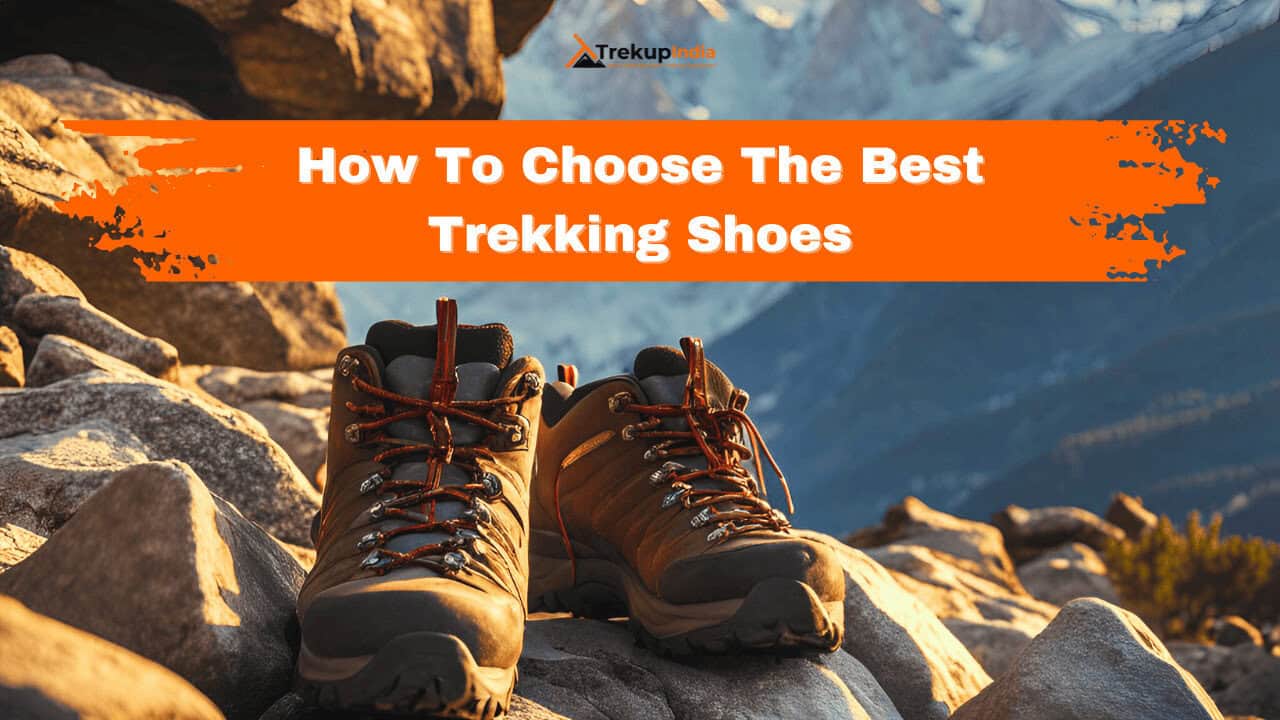



Know Everything About Acute Mountain Sickness
Acute Mountain Sickness occurs when people trek to high altitudes above 8,000 feet. This condition itself develops further due to reduced oxygen levels at such heights. Basically, as you go higher up, the air pressure and oxygen levels decrease, which causes the same problem. Acute Mountain Sickness surely causes headache, nausea, vomiting, and dizziness in affected persons. Moreover, peoples also experience difficulty in sleeping during this condition. To avoid mountain sickness, you should actually trek up slowly to higher altitudes. To learn further about this condition itself, watch the videos by Trekup India.
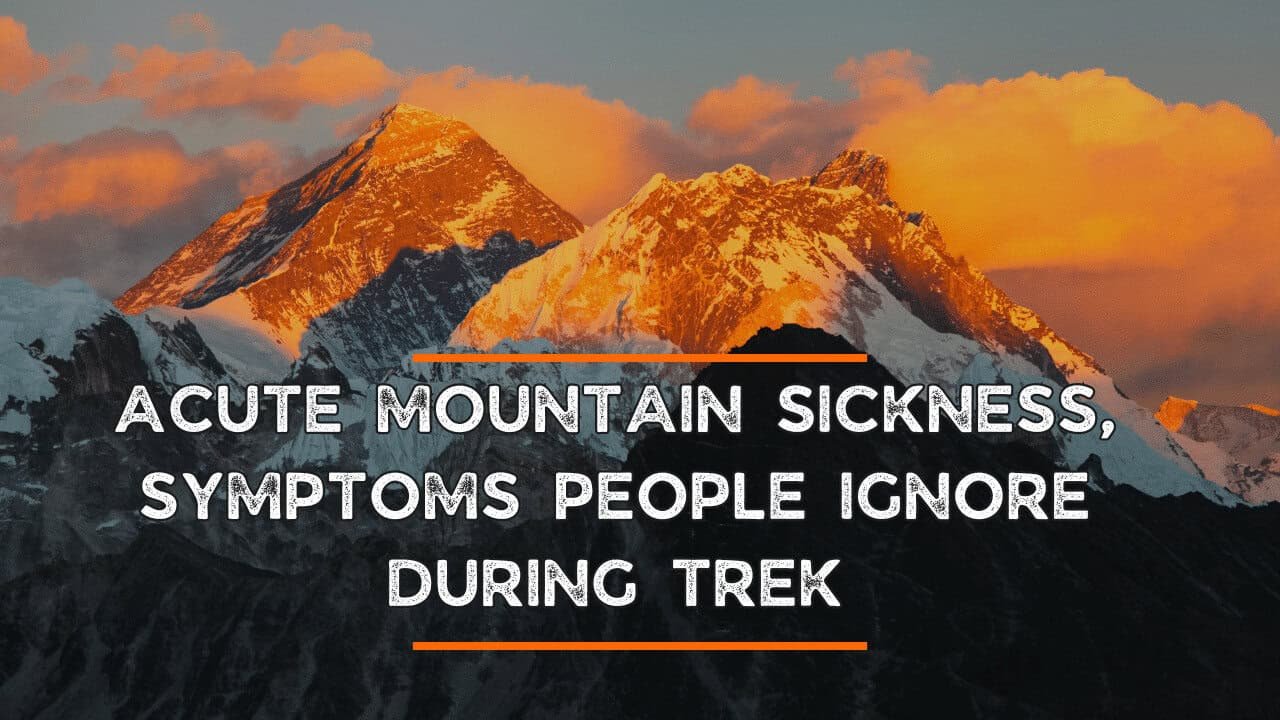
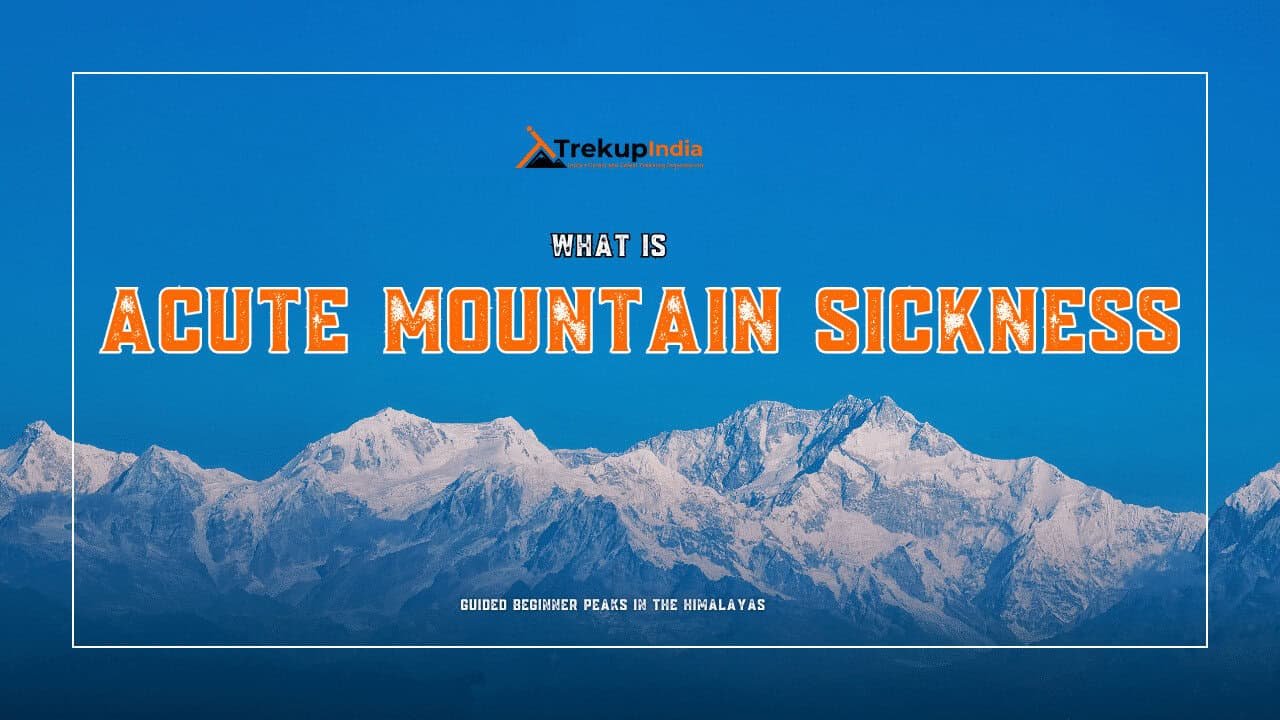
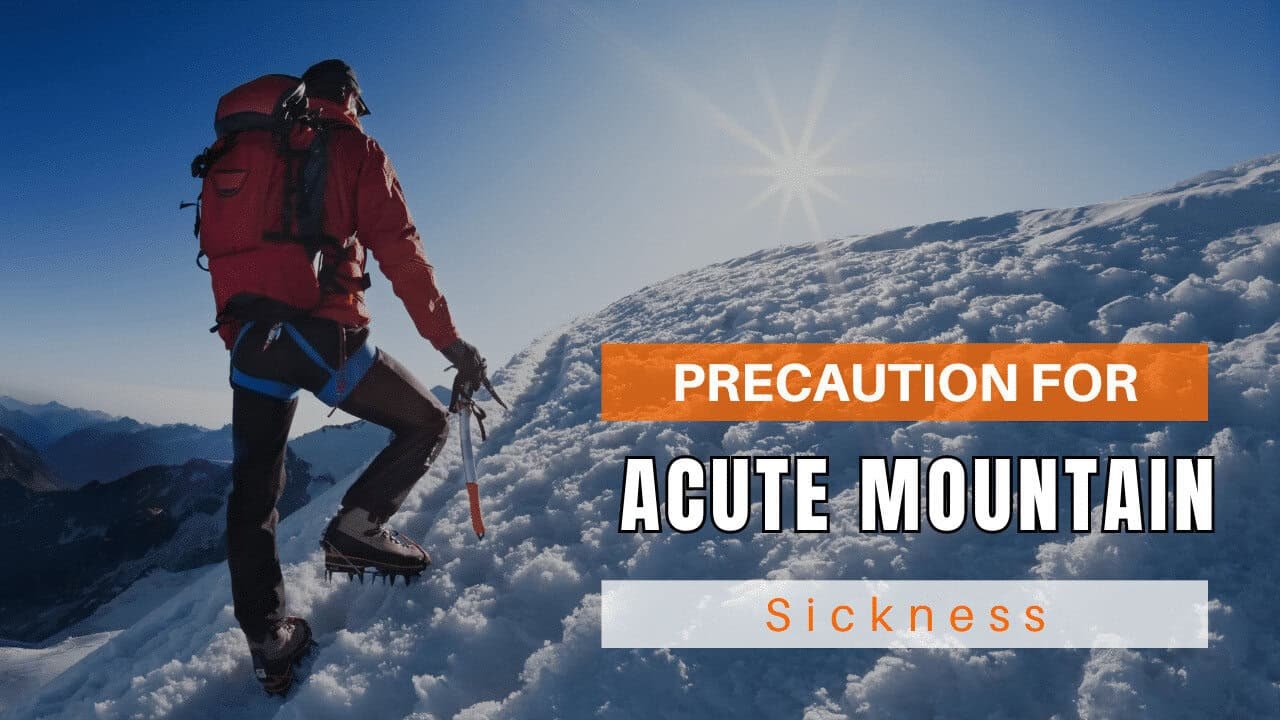
Day Wise Detailed Itinerary of Hampta Pass Trek
Day 1: By Road from Manali to Jobra, Trek from Jobra to Chika
- Altitude: The trek covers three altitudes – Manali (6730 feet / 2050 meters), Jobra (9800 feet / 2987 meters), and Chika (10,100 feet / 3078 meters).
- Altitude Gain: The altitude gain during the trek is 3070 feet / 937 meters from Manali to Jobra and 300 feet / 91 meters from Jobra to Chika.
- Drive Distance: 15 Kms
- Drive Duration: 2 Hrs
- Trek Distance: 1.5 Kms
- Trek Duration: 2 Hrs
- Stay: Overnight stay at the camp.
- Meal: Dinner will be provided.
- Trek Grade: The trek is graded as gradual from Jobra to Chika, ensuring your safety and comfort throughout the journey.
To begin your trek to Chika, you must first travel by road from Manali to Jobra. The drive will take around 2 hours, and along the way, you will encounter 30 hairpin bends, which is an adventure in itself. As you start the trek, after walking for a short distance, you will see the Rani Nallah flowing directly through the meadow, with cows and sheep roaming around the grass fields, making it look like something out of a fairytale. You will be walking through the meadow on the left side of the hill. Regardless of which way you choose, you will eventually reach Chika, which is situated at the bottom of the meadow’s vast expanse. However, climbing the hill and descending to Chika is the best and most convenient way. The Chika campsite is an ample, beautiful green space, and the Rani River is the perfect spot to set up camps.
Day 2: From Chika to Balu ka Ghera By Trek
- Trek Distance: 8.5 Kms
- Trek Duration: 6 Hrs
- Overnight stay at the camp is included in the package.
- You will be provided with breakfast, lunch, and dinner during your stay (B/L/D).
- The trek distance for this part of the journey is 8.5 km and it usually takes around 6 hours to complete.
- The altitude at Chika is 10,100 ft / 3078 mtr and at Balu ka Ghera is 11,900 ft / 3627 mtr.
- The altitude gain is 1800 ft / 549 mtr and the trek grade is gradual to moderate.
As you embark on your trek, you will be welcomed by a picturesque view of the river flowing on your right-hand side. To fuel your journey ahead, you will be served a delicious breakfast. Although the trail may be slightly challenging due to rough terrain, it won’t be too difficult. As you progress further, you will enter a beautiful forest adorned with Rhododendron trees. The snow-capped Dhauladhar range will be visible in all its glory, and you will also witness a mesmerizing waterfall along the way.
To continue your journey, you will need to cross the river to reach the other side, where you will be greeted with an array of multicolored flowers. After crossing the river, you will arrive at a stunning campsite called Balu ka Ghera. The name of this campsite comes from a mound and sand-covered area, and the terrain becomes flat as you approach it. You can relax and enjoy the tranquil surroundings of Balu ka Ghera before continuing your journey ahead.
Day 3: Trek from Balu ka Ghera to Hampta Pass and then to Shea Goru
- Altitude: The trek will cover three locations with varying altitudes – Balu ka Ghera (11,900 ft / 3627 m), Hampta Pass (14,100 ft / 4298 m), and Siagoru (12,900 ft / 3932 m).
- Altitude Gain: The altitude gain during the trek will be Balu ka Ghera to Hampta Pass (2200 ft / 662 m) and Hampta Pass to Shea Goru (1200 ft / 366 m).
- Trek Distance: 7 Kms
- Trek Duration: 10 Hrs
- Stay: Overnight stay at the campsite.
- Meals: Breakfast, Packed Lunch, and Dinner will be provided.
- Trek Grade: This trek is rated as moderate to difficult.
You will have hot tea with breakfast. The trek is divided into two parts: In the first half, you will be trekking from Balu ka Ghera to Hampta Pass, and in the second half, you will be trekking from Hampta Pass to Shea Goru. The trek from Balu ka Ghera to Hampta Pass is steadily ascending along moderately steep slopes until you reach Hampta Pass. From Hampta Pass, it is a downward descent to Shea Goru.
The trail runs along the river’s side, with stunning views of tiny orange and yellow flowers offering a beautiful view. After that, the actual climb up to the Hampta pass starts, which is vertical. Once you have reached Hampta Pass, you can enjoy the breathtaking view from the point.
From there, the trek descends, which is a little steep and should be done carefully. After you reach the bottom, you will reach the valley, after which lies Siagoru. This campsite is also along the riverside.
Day 4: Trek from Shea Goru to Chatru, then drive to Chandratal. Immerse Yourself in the Tranquility of the Moon Lake Chandratal
- Altitude: Siagoru (12,900 Ft / 3932 Mtr.), Chatru (11,000 Ft / 3353 Mtr.)
- Altitude Gain: 1900 Ft / 579 Mtr.
- Trek Distance: 7 Kms
- Trek Duration: 5 Hrs
- Stay: overnight stay at the campsite.
- Meal: Breakfast, Lunch, Snacks & Dinner
- Trek Grade: Gradual
Trekking from Shea Goru to Chatru provides a serene experience immersed in nature. The trek spans 7 kilometers and takes approximately 5 hours, with an altitude loss of 550 meters (1,900 feet) as you descend from Shea Goru at 12,900 feet to Chatru at 11,000 feet. It is advisable to start early in the morning, as there are 2 to 3 water sources along the route, and a hot meal will be available at the campsite upon your arrival.
The trail follows the riverbank, winding between the mountains and offering breathtaking views. However, be cautious, as some areas may be slippery. The landscape is largely barren, with little vegetation, making this portion of the trek challenging. Careful navigation is essential, especially near the edges of mountains or ridges.
Although the descent will take around two hours, you can still find enjoyment in the experience despite its challenges. You will cross two glaciers on your way to Chatru, which is located just beyond them and serves as the next camping area. Choose a campsite where the river flows around you for a truly picturesque setting.
Chatru is an intersection of three passes: Hampta, Rohtang, and Spiti, and it is conveniently located only an hour away.
Day 5: By Drive from Chatru to Manali 60 kms
- Altitude: Chatru (11,000 Ft / 3353 Mtr.), Manali (6730 Ft / 2050 Mtr.).
- Altitude difference: 4270 Ft / 1303 Mtr.
- Drive Distance: 60 Kms
- Drive Duration: Approx. 4-6 Hrs
- Stay: None
- Meal: Breakfast.
On the last day of your trip, you will be driving from Chatru to Manali. Enjoy the beautiful mountain scenery one last time before returning to the plains.
On day five, a return trip from the Chatru campsite to Manali is scheduled. This 4-hour drive will be filled with sweet memories of the mountains, and you will arrive in Manali at night.
We’ve prepared a comprehensive Trek Route Map for your upcoming adventure to Hampta Pass Trek, which outlines the entire journey including all stops and trails. This map provides detailed information on the terrain, distance between points of interest, and estimated travel time to help ensure a safe and enjoyable trek. We’ve carefully curated the map to ensure that you have all the necessary information at your fingertips. Please take a moment to review it thoroughly, and don’t hesitate to reach out if you have any questions or concerns.
The Hampta Pass Trek Altitude Chart is a useful tool for trekkers to monitor their altitude changes during their rides, allowing them to plan their routes more efficiently and track their progress over time. This Hampta Pass altitude chart is beneficial for both casual and experienced trekkers, helping them make the most out of their trek experience.

Trek Cost Inclusions
- Stay: 4 Nights of tented accommodation at individual campsites of Trekup India on twin sharing.
- Meals: Trekup India will provide freshly cooked meals during the trek starting with Lunch on Day 1 to Breakfast on day 5 (Meals are simple, nutritious, and vegetarian)
- Trek Insurance (Optional): Trekup India recommends that all trekkers consider getting trek insurance. This is optional, but highly recommended. Trek insurance covers unexpected events that may occur during your trek. The cost of the insurance starts from INR 210. Please read more about what is included in the coverage and why it is mandatory on treks.
- Trek Equipment: Sleeping bag, Sleeping tents, Kitchen tent, Dining tent, Toilet Tent.
- Amenities: All utensils, sleeping mattresses (Black foam mats), Crampons, and Gaiters for snow.
- Health & Safety: First Aid Box, Oxygen Cylinders, Stretchers, Oxi meters, BP Machines, health.
- Permits: Forest Permits and Camping Permission Fee
- Trek Crew: High Altitude Chef, Helpers, Trek Leader & Guides, and other support teams.
- Potters & Mules: Potters and Mules are to carry all trekking equipment, ration, and vegetables.
Trek Cost Exclusions
- Transport: ₹1600 Extra For Transport From Manali to Jobra & Chatru to Chandratal to Manali Return
- GST 5% (it is Mandatory)
- Any Meals/accommodation beside the itinerary or not mentioned in the program.
- Any Bus / Airfare to/from trek start/end point
- Personal Medical expenses do carry your medication.
- Any personal services such as Laundry, phone calls, liquors, mineral water, etc.
- Any still / video camera fee
- Any Entrance fee Monuments, Monasteries, Museums, Temples – Pay directly on the spot.
- Backpack Offloading (Mule/Porter Charges)
- Offload Charges: ₹1,680 per bag for the full trek if paid online in advance.
- On-spot Payment: Charges may increase by up to 30% if paid at the base camp.
- Weight Limit: Each bag must not exceed 10 kg.
- Note: Offloading is optional and is recommended for those who prefer to trek with a lighter daypack.
- Any emergency evacuation charges
- Any services that are not mentioned in the cost inclusion section.
What should you pack for the Hampta Pass Trek
Hampta Pass Trek is a high-altitude trek. The trekking gear you have to have for this particular trek differs from normal treks. Thus, read this whole segment. There is an important question that the trekker who is doing trek asks, like what all things to carry while trekking. Below, we have provided the details on everything you should take; an easy way to remember is by Head to foot or foot to head. We have prepared from Head to foot.
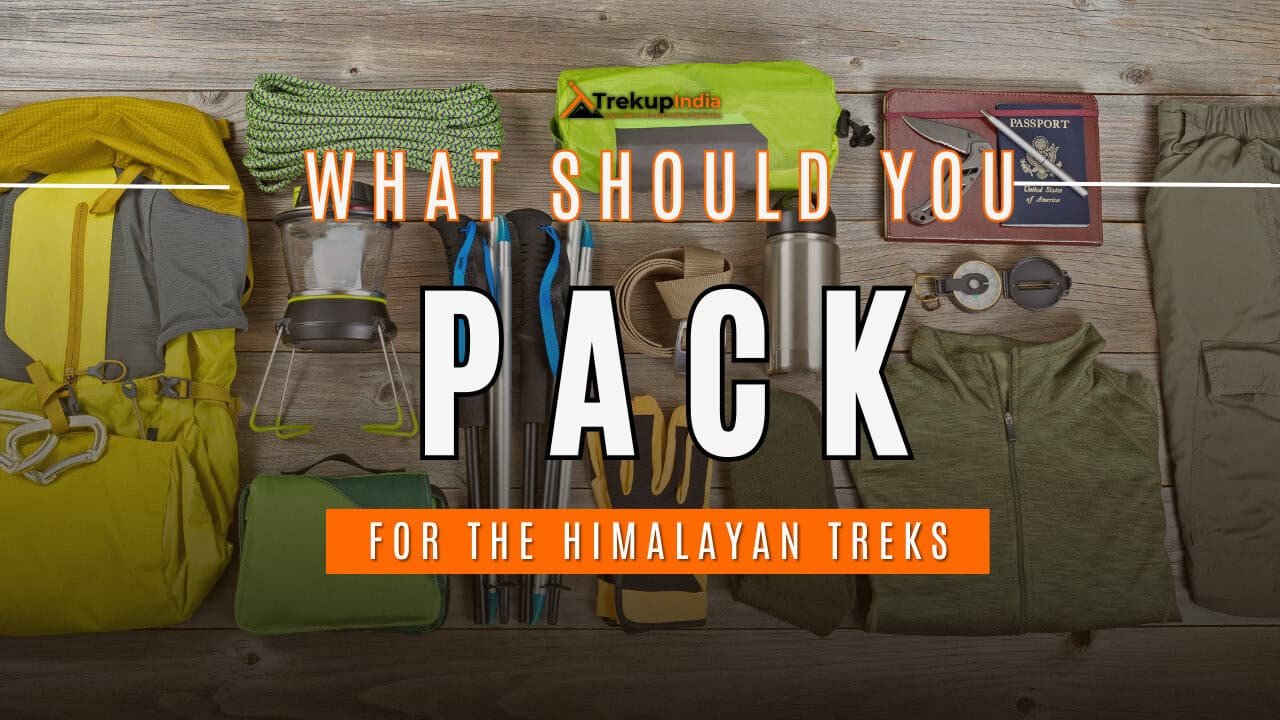
Head Gears
When trekking it's important to carry headgear to protect your head and face.
Heading out for a trek? Don’t forget to carry headgear to protect your beautiful face and head from the sun, wind, and dust! It’s an essential accessory that keeps you safe and comfortable throughout your adventurous journey. So, make sure you pack it before you step out into nature!
- Head Lamps – When trekking at night, headlamps are essential to illuminate your path while keeping your hands free. Headlamps come in different sizes and lumens, so it is essential to choose one that suits your needs.
- Hats or Cap – Caps or hats are also necessary when trekking in different weather conditions. Caps protect your head from the wind and freezing temperatures at night, while hats provide shade and protection from the sun during the day. It’s essential to ensure that your hat has a strap to prevent it from being blown away by the wind.
- Sunglasses – Sunglasses are also essential for trekking. Your sunglasses should protect your eyes from harmful UV rays and fit your face perfectly to avoid falling off while climbing, jumping, or crossing obstacles. The glass of your sunglasses should also be designed for different weather conditions to provide optimal visibility.
- Buff / Balaclava – Lastly, a buff or balaclava is a must-have to protect your mouth or neck from extreme temperatures and keep them warm. Buffs and balaclavas come in different materials, thicknesses, and designs, so it’s important to choose one that suits your needs and preferences. Depending on the weather conditions and your activities, you can wear them as neck warmers, face masks, or headbands.
Clothes
When trekking in high altitudes, prepare for cold weather by wearing layers. Layering traps heat, keeps you warm, and allows you to easily adjust your clothing as temperatures fluctuate.
Layering is important for different seasons when trekking. When planning a high-altitude trek, it is important to prepare for the cold weather. Wearing layers is the best approach as it provides both protection and flexibility when the weather changes frequently in the mountains. Layering helps to trap heat and keep your body warm, while at the same time allowing you to easily adjust your clothing as the temperature fluctuates. By wearing layers, you can enjoy your trek comfortably and stay safe in the unpredictable mountain weather
- For spring, summer, and monsoon treks, consider wearing three layers: a woollen sweater, a fleece, and a padded jacket.
- For autumn treks, add one more fleece layer to make it four layers.
- For winter treks, you may need five layers with thermals, a woollen sweater, two fleeces, and a padded jacket.
- T-shirt/sleeve shirt– Bring three T-shirts and two quick-dry trek pants, wearing one and carrying the others. Long sleeve shirts help to protect from sun UV rays. We recommend synthetic T-shirts as they get dry quickly when they get wet.
- Hiking / Trekking Jacket– down jackets (-5 to-10 C) or two-three-layer jackets.
- Thermals– at least two pairs of thermals help keep the body warm during cold weather.
- Undergarments– you can carry them according to your habitual and hygiene requirements.
- Gloves– 1 pair of gloves will keep your hand warm and nice.
- Trek Pants– Bring 2 to 3 comfortable trekking pants. Trekking pants play a significant role, as they are designed for comfort and mobility, making trekking easier. It should be Synthetic so that it gets dry quickly when wet.
- Rain Wear– you can carry a raincoat or Poncho. During long rains and snowfalls, the waterproof jackets start leaking. Still, the Poncho and raincoats keep you dry, so choose accordingly.
Tip: If you choose a raincoat on your trek, carry a small waterproof cover so things inside your backpack can’t get wet. If you carry a Poncho, you don’t need to worry. It protects both you and your backpack.
Foot Gears
When it comes to planning a trek, one of the most important aspects is to ensure that you have the right kind of foot gear.
- Trekking shoes which are waterproof and have ankle support. Walking / Hiking sandals which can be used off the trek, i.e., in the morning and evening hours when you reach the campsite, basically to get your feet rest from heavy boots, sometimes used for crossing streams and rivers, it’s more comfortable and safer than crossing barefoot or wetting your shoes. Sneakers (Optional) can be worn for normal driving days or used around the camp.
- Socks– you should at least carry 3 to 4 pairs.
- Microspikes & Gaitorswill be provided by Trekup India when required. You don’t have to carry them.
Personal First Aid Kit
Don't forget to pack your personal first aid kit! It's always better to be safe. So, make sure you're prepared for any unforeseen circumstances.
Below are some common medicines generally required/used during your adventure trip; however, please consult your doctors prior.
- Antiseptic towel or water syringe (to clean the wound)
- Butterfly bandage for a small cut
- Cotton and elastic bandages and sterile gauze pad for larger wounds
- Latex gloves are used when the wound bleeds.
- Medicine for Diarrhea (Upset stomach)
- Medicine for cold, flue/fever, headache
- Some pain killers
- ORS pouches
- Quick pain relief spray (External use)
- Any personal medicine prescribed by your doctor
- Dimox / Similar for high altitude sickness
- Bug Repellent
- Carry some nutria/energy bars and drinks (non-alcoholic)
- Note: Kindly consult your doctor before purchasing or taking any medicine.
Gadgets and Other Items
You might also consider bringing a camera, binoculars, portable charger, and snacks. Be well-prepared and tackle any trail with confidence.
- Trekking Poles
- Mobile phone
- Camera
- Spare batteries for phone and camera, power bank
- Lightweight flashlight or headlight
- A waterproof bag made of plastic is used for the camera.
- Plug/converter for electrical items
- 1-litre water bottle
- A journal with a pen would be a good idea to keep your notes.
- Some book of your interest for the ideal time
- Get into the habit of maintaining a Map and guidebook of the region.
Hygiene & Personal toiletry
Remember to pack hygiene and personal toiletry items such as soap, shampoo, toothbrush, toothpaste, deodorant, and toilet paper.
- Sunscreen with UV protection to shield your skin from harmful rays
- 1 or 2 small quick-drying towels to help you dry off quickly in case of rain or sweat
- Toilet paper, tissues or wet wipes for maintaining hygiene while on the trek
- Toothbrush, toothpaste, and mouth freshener to keep your mouth clean and fresh throughout the journey
- Deodorant or talcum powder to help you stay fresh and odor-free, especially during hot and humid climates
- Shampoo to keep your hair clean and healthy
- Sanitary pads or tampons (for female trekkers) to manage menstrual cycles
- Lip-gloss or salve to protect your lips from dryness and chapping
- Bio-degradable soap to keep yourself clean and hygienic while on the trek
- Nail clipper and other personal items that you use daily
Compulsory Documents to Carry
There are certain documents that you should always carry with you. These documents are not only necessary for your safety and security, but they may also be required by local authorities.
These files must be submitted to the Forest Department before your trek. With none of these, you will not be permitted to trek—original and photocopy of government photo identity card. Carry IDs like Aadhaar, voter ID, etc.
How To Plan Your Trek & Reach Manali, Himachal Pradesh?
It’s important to note that all participants must reach Manali at the start of the program. To cater to your travel preferences, we offer three options:
Option 1: Consider traveling overnight on a government bus to Manali. The journey takes 14 hours from Delhi and 10 hours from Chandigarh. We strongly recommend government buses over private ones, as they are more reliable and less likely to be delayed. Regardless of your choice, aim to reach Manali between 9 and 10 am.
Option 2: If you prefer to fly, the best option is to fly to Delhi or Chandigarh airport, then take a bus to Manali. Another alternative is to fly to Bhuntar Airport, which is only two hours away from Manali. However, we advise against this due to the high flight costs and potential for cancellations. If you do choose to fly to Bhuntar, ensure you arrive at least a day before the trek begins.
Option 3: It is possible to go by train. Pathankot railway station, from where you can take bus services that direct you to Manali which is about 300 kilometers from the station and will require an overnight trip. If you choose this option, it is best to arrive one day prior to Manali.
Rest assured, when you arrive at the trek assembly point in Manali, Trekup India will take care of your journey to Jobra, Chatru, and back to Manali, including an excursion to Chandratal. Please ensure you reach Manali before 10:30 am on the first day of the program to allow for a timely departure to the assembly point.
Fitness Required & Preparation Guide For Hampta Pass Trek
If you’re preparing for a Hampta Pass Trek, Trekup India recommends jogging as part of your fitness routine. Jogging helps work out the same muscle groups that you’ll use during trekking and can help you build endurance. You don’t need any special equipment to get started.
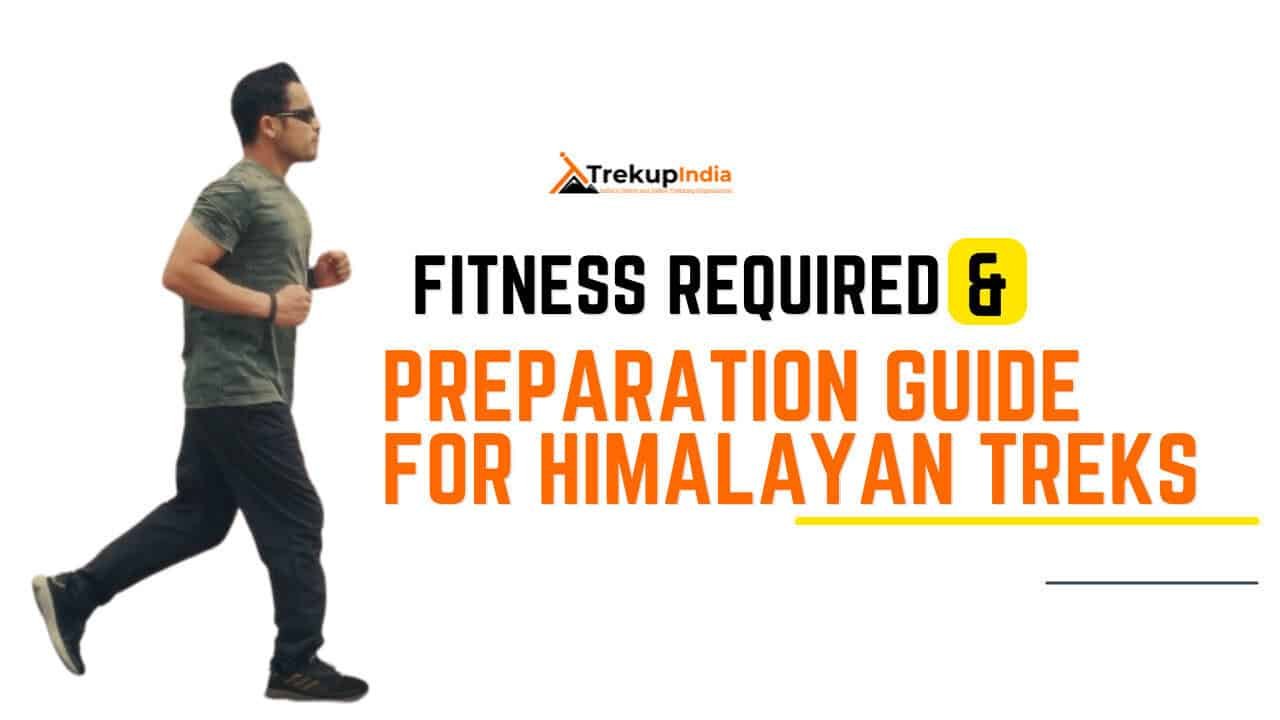
Fitness Target
Trekup India has put the Hampta Pass Trek into an easy-to-moderate-grade-level trek.
For Easy – Moderate Treks – In order to be well-prepared for your upcoming trek, it is recommended that you focus on building your endurance by aiming to cover a distance of 4.5 kilometers in less than 45 minutes. This will help you to develop the necessary stamina and strength required to successfully complete your journey.
How to Achieve This Fitness Target?
To start preparing for your trek:
- Try jogging for at least five days every week.
- If you find 4.5 km too difficult at first, begin with 2 km and gradually increase over 2-3 weeks.
- Once you feel more comfortable running 4.5 km, focus on improving your speed gradually on a daily basis.
It is important to ensure that you can consistently complete 4.5 km in under 45 minutes for at least two weeks before your planned trek. Allow yourself 6-8 weeks to prepare physically for the journey.
Strength Training exercises that benefit Trekking
Trekking is an activity that demands a good level of strength.

Trekking is a demanding activity that requires good cardiovascular endurance, muscular strength, and overall fitness. To help you prepare for your trek, incorporating bodyweight exercises into your training routine can be an effective way to build strength, improve stability, and enhance endurance, all of which are crucial for a successful trek. In this regard, here’s a breakdown of body weight exercises categorized by the specific body parts they target and the benefits they offer during trekking.
1. Lower Body Exercises
Lower body exercises like squats and lunges are great for building lower body strength, essential for trekking.
a. Squats
Squats are an excellent exercise for building lower body strength, essential for trekking. They target the quadriceps, hamstrings, glutes, and calves. Solid quadriceps and glutes provide power for ascending and tackling uphill climbs, while vital hamstrings aid stability during descents. This is particularly helpful in navigating uneven terrain during trekking.
How to perform Squats Exercises:
- Stand with feet shoulder-width apart, toes pointing slightly outward.
- Lower your body by bending your knees and hips, keeping your back straight.
- Lower until your thighs are parallel to the ground or as low as comfortable.
- Push through your heels to return to the starting position.
b. Lunges
Lunges target the quadriceps, hamstrings, glutes, and calves. They improve lower body strength, balance, and stability, crucial for maintaining control on rocky trails and steep slopes. Additionally, they enhance flexibility, reducing the risk of injury while trekking.
How to Perform Lunge Exercises:
- Stand with feet hip-width apart, hands on hips or sides.
- Take a step forward with one foot, lowering your body until both knees are bent at 90-degree angles.
- Push through the heel of your front foot to return to the starting position.
- Repeat on the other side, alternating legs.
2. Upper Body Exercises
Upper body exercises such as push-ups and pull-ups effectively strengthen the upper body, especially the chest and shoulders, which are essential for carrying a backpack during treks.
a. Push-Ups
Targets: Chest, shoulders, triceps, and core.
Benefits for Trekking: Push-ups are an effective exercise to strengthen the upper body, especially the chest and shoulders, essential for carrying a backpack during treks. Improved upper body strength will also help maintain posture and stability while traversing challenging terrain.
How to Perform Push-Ups Exercises:
- Start in a plank position with hands shoulder-width apart and body in a straight line from head to heels.
- Lower your body by bending your elbows until your chest nearly touches the ground.
- Push through your palms to return to the starting position.
- Keep your core engaged throughout the movement.
b. Pull-Ups/Bodyweight Rows:
Targeting the back, biceps, and shoulders can significantly benefit trekking. You can strengthen these muscle groups by performing pull-ups or bodyweight rows and improve your posture and balance while carrying a backpack. Additionally, more muscular back muscles can help reduce the risk of back strain and fatigue during long treks, making your journey safer and more comfortable.
3. Core Exercises
Core exercises like planks and Russian twists can help strengthen the core muscles, which are crucial for maintaining stability and balance while trekking on uneven terrain.
a. Planks
Targets: Abdominals, obliques, and lower back.
Benefits for Trekking: Planks are an effective exercise that helps strengthen the core muscles. These muscles are crucial for maintaining stability and balance while trekking on uneven terrain. A strong core also helps improve posture, reducing the risk of back pain and fatigue during extended hikes.
How to Perform Planks Exercises:
- Start in a plank position with elbows directly under shoulders and body in a straight line from head to heels.
- Engage your core and hold the position, avoiding sagging or arching the back.
- Keep breathing steadily and hold for the desired duration.
b. Russian Twists
Targets: Obliques, abdominals, and lower back.
Benefits for Trekking: Russian twists engage the core muscles, particularly the obliques, improving rotational stability and balance. Enhanced core strength helps prevent injuries and improves overall performance during trekking.
How to Perform Russian Twist Exercises:
- Sit on the ground with knees bent and feet flat, leaning back slightly to engage the core.
- Clasp hands together and twist the torso to one side, bringing the hands towards the ground beside the hip.
- Return to the centre, then twist to the other side.
- Continue alternating sides for the desired number of repetitions.
4. Full Body/Cardiovascular Exercises
Full-body/cardiovascular exercises like burpees and mountain climbers are excellent for improving cardiovascular endurance, strength, and agility.
a.Burpees
Burpees are an excellent full-body exercise that targets your legs, chest, arms, and core. This exercise dramatically benefits trekking enthusiasts, improving cardiovascular endurance, strength, and agility. Regularly incorporating burpees into your workout routine can enhance your overall fitness level, which can help you endure long hikes and rugged terrains with ease.
How to Perform Burpees Exercises:
- Start in a standing position.
- Squat down and place hands on the ground.
- Jump feet back into a plank position.
- Perform a push-up.
- Jump feet back to the squat position.
- Explosively jump up into the air, reaching overhead.
- Land softly and repeat the sequence.
b. Mountain Climbers
Mountain climbers target the core, shoulders, chest, and legs. This dynamic, full-body exercise can significantly improve cardiovascular endurance and agility. It is an excellent functional workout for trekking preparation as it engages both the upper and lower body muscles while strengthening the core muscles.
How to Perform Mountain Climbers Exercises:
- Start in a plank position with hands shoulder-width apart and body in a straight line from head to heels.
- Drive one knee towards the chest, then quickly switch legs, alternating in a running motion.
- Keep the core engaged and the hips stable throughout the movement.
- Continue at a moderate to fast pace for the desired duration.
Incorporating bodyweight exercises into your training routine can help you build strength and endurance and prepare your body for the physical demands of trekking. Consistency and proper form are crucial to maximizing the benefits of these exercises and ensuring a safe and enjoyable trekking experience. Engaging your core muscles, including obliques, abdominals, and lower back, with Russian twists can improve your rotational stability and balance, preventing injuries and enhancing overall performance during trekking.
When incorporating strength training exercises into your workout routine, it’s essential to maintain proper form and technique to avoid injury. Start with lighter weights and gradually increase the intensity as you progress, focusing on compound exercises targeting multiple muscle groups simultaneously. Some examples of practical strength training exercises for trekking include squats, lunges, deadlifts, and pull-ups.
Remember to give your muscles time to recover between workouts, and remember to stretch before and after your workouts to prevent injury and improve flexibility. Combining strength training with jogging and proper stretching allows you to take your fitness to the next level and confidently tackle even the most challenging treks.
Our Trekkers Reviews And Expreinces





We provide only Indian vegetarian food, and your meal will mainly consist of Indian bread, vegetables, lentils, rice, and a delicious dessert. During your trek, we will serve three meals a day, including breakfast, lunch, and dinner. You will also be served tea, snacks, and lip-smacking soup in the evening before dinner. If it is a long day of trekking, you will be given a packed snack.
After extensive research on the trekkers’ nutritional requirements, we prepare the menu. Before putting all the meals together, we also consider the altitude and the weather.
The meal we serve during the trek is perfectly balanced with calories, carbohydrates, vitamins, protein, fibre, and minerals. You need to know that all our cooks have great expertise in cooking and have undergone thorough training. So, get ready to enjoy delectable and lip-smacking dishes during your trek. You will be served with lemon tea in the tent to start your day with a refreshed feeling. Before leaving the campsite for trekking, you will be given a hot finger-licking breakfast like upma, Aallu Prantha, Besan Chilla, Poha, Daliya, Corn flakes, and Maggie, along with tea or coffee.
If your trek is longer, we also offer some fresh local fruits such as apples and healthy drinks like Frootie or Maaza. In the afternoon, you will be served a simple & healthy lunch, while at around 04:00 pm, you will be given tea and a light evening breakfast. After you reach your campsite at night, you will be served a hot and delightful dinner.
After reading this, you must have understood the food we provided on the trek; you don’t need to worry about food. Many trekkers repeatedly trek with us because of the food we provide. Thus, we will give you unforgettable experiences.
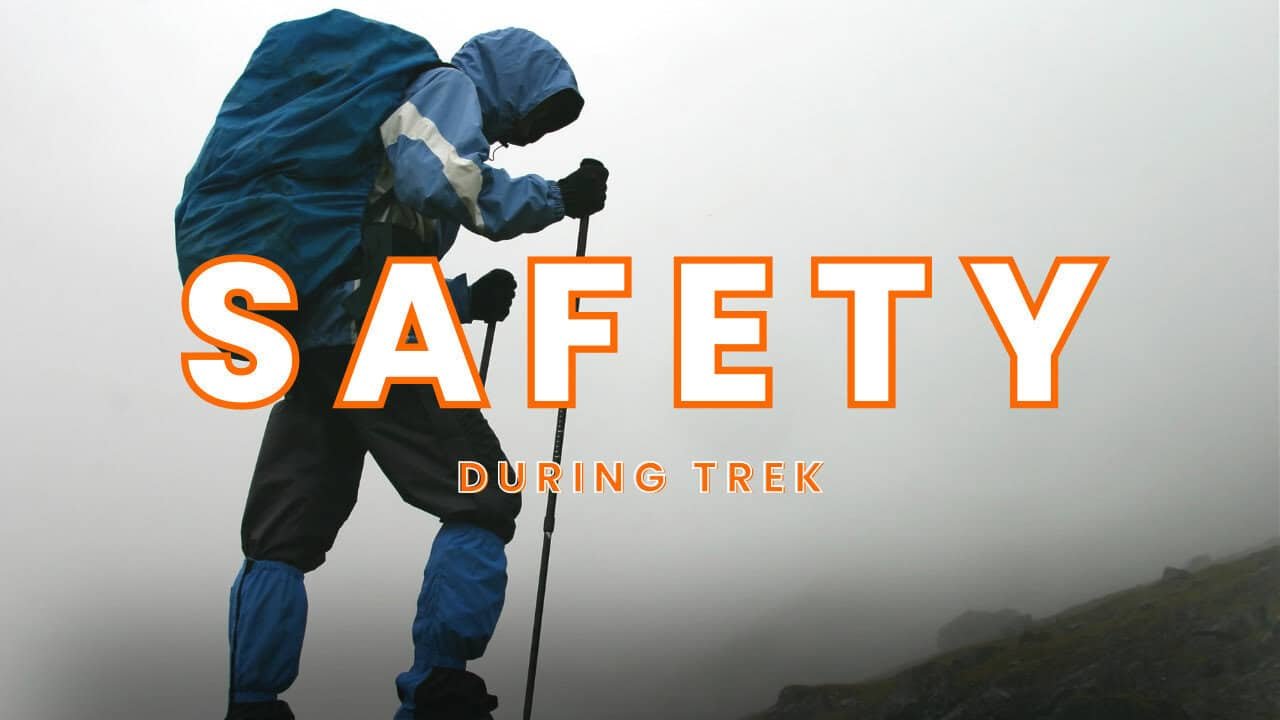
Trekking with us for the Hampta Pass Trek is entirely safe because we have a team of trek leaders qualified in Wilderness first-aid and complete information about the high-altitude glitches. During the trek, we carry a full first-aid kit that contains all the essential medicines. Before trekking with us, you must ensure that you are medically fit for the trek; for us, your medical fitness is more important than anything else.
Right from our establishment, we at Trekup India have been continuously introducing new safety practices into Indian trekking to ensure the safety of voyagers. Trekup India introduced microspikes and made emergency bottled oxygen mandatory for all treks. Our trek leaders take your daily Pulse oximeter reading. We at Trekup India introduced the radio walkie-talkie as a safety communication device.
How can we ensure that your trek is safe with us?
We have noticed that most trek-organizing organizations do not follow these systems, but with time, they are following us; several competing companies are adopting these practices and organizing great, safe treks.
We ensure complete technical safety in the mountain. Our company has a vast team of more than 100 guides and trek leaders who serve on Himalayan treks. One of the best things about our team is that all the members are trained professionally by the Nehru Institute of Mountaineering, Indian Mountaineering Foundation Delhi, and Hanifle Center Outdoor Education Mussoorie.
Explore our New Safety Protocols
To ensure a perfect Trek, we have introduced some new safety checks to ensure excellent safety for our trekkers.
Our On-trek safety checks include:
- Daily oxygen saturation, along with pulse readings
- Stretchers team appointed on every trek
- Radios
- Trained mountain staff and complete safety
- Additional oxygen cylinders
- Special medical kit for high-altitude treks
- Microspikes on all types of snow treks
- Experienced Trek leaders, as well as safety
- Technical team on all snowy slopes
For Us, Your Safety Is the Top Priority
At Trekup India, you will find a team with local knowledge and fluency in English and Hindi. This helps ensure that you have a fantastic trek. Not only this, but we also pay attention to your health and safety because this is something we cannot ignore. All the team leaders involved in trekking have already undergone several professional courses in first aid, portable altitude chamber training, CPR, environmental awareness training, and advanced wilderness emergency medicine.
We also carry a complete first aid medical kit on every trek and trip we organize. Apart from the medical kit, we take a portable altitude chamber (if needed) and medical oxygen for all high-altitude treks. Our company has significant expertise in organizing all sorts of group adventure holidays for family groups, school and college groups, and friend groups. We have many travel options that suit different fitness levels and travelling styles.
Regardless of the group size, we value each and every member of our trekking groups. Our commitment to personal attention ensures that your needs and safety are always our top priority.
Who we are?
Trekup India has been a stalwart in the Adventure Tourism industry for 30 years. Since our inception, we have been dedicated to providing top-notch treks, voyages, trekking programs, and high-altitude expeditions. Our extensive experience is a testament to our commitment to your adventure and safety.
We organize treks in Uttarakhand, Kashmir, Sikkim, and Himachal while being part of the trekking community; we feature more than 75 documented Himalayan treks. In addition to other outdoor activities, our company also organizes trips for schools, colleges, and families.
Therefore, we maintain the quality of services offered to our valuable customers.
Must Read These Information Of Hampta Pass Trek
Why You Should Do Hampta Pass Trek?
If you are looking for an unforgettable experience in nature, you should visit the beautiful meadows, pine and oak trees, waterfalls, and flowers. The drive from Manali to Jobra is exciting, with 30 hairpin bends and scenic views of the mountains. Once you reach the 30 hairpin bends, you can enjoy the breathtaking panoramic view of the Kullu Valley from an altitude of almost 10,000 feet. It is truly a mesmerizing sight to behold.
When you reach Jobra, you will witness the cascading beauty of the Rani Nala / Stream, one of the most stunning streams in the region. The crystal-clear water flowing over rocks and boulders creates a soothing sound that adds to the place’s charm. You can also hike through the pine and maple trees surrounding the stream, which is a perfect way to experience nature.
The Conifers Forest in Chika is another sight, with its majestic views. The tall and slender pine trees stand tall, creating a dense and lush green forest that is a treat for the eyes. The forest is home to various birds and animals, making it a perfect place for wildlife enthusiasts and nature lovers.
Balu Ka Ghera, which translates to Bear Cave, is a unique location with sand and mounds formed from river deposits but no actual caves. It is a popular spot for camping, and you can enjoy a night under the stars amid nature. The dunes and mounds are a perfect spot for photography, and the tranquillity of the place will surely calm your mind and soul.
Finally, visit the stunning Chandratal Lake, crescent-shaped and nestled in the hills at around 14,000 feet. The lake offers a spectacular view of the surrounding landscape, and the crystal-clear water reflects the majestic mountains surrounding it. It is a perfect spot for camping, trekking, and photography and a must-visit for anyone who loves nature.
Best time to do Hampta Pass Trek
In peak times for winter, there is heavy snow, so it becomes difficult to trek. The ideal time to do this trek is from June to October. As the snow has melted, you can enjoy the greenery, waterfalls, and rivers. You can see snow in June, and in July and August, you can see flowers, marigolds, and blue poppies. These are well-known flowers, but you will also know the wildflowers beside the trail. You could enjoy some rain in the mountains at the end of August and early September. In September, you can see the autumn colours and snow-covered hills in the clear view of the blue sky. The weather gets chilly by October, and the temperature drops below zero.
Substantial snowfall is anticipated beyond Balu Ka Ghera in June. The area slightly past Balu Ka Ghera camp and up to the pass will have good snow cover, and the Lahaul side will also experience snow. The snow depth on both sides is considerable. There may be patches of snow on the flats leading to the grassy camp of Shea Goru. The valley’s narrow shape and limited sunlight contribute to the abundant snow in late June.
In June, anticipate a substantial snowfall starting from Balu Ka Ghera and continuing throughout the journey to the pass. The snow will persist until you reach the Lahaul side, with both sides featuring considerable snow depth. The flat areas leading up to the grassy Shea Goru camp may also have scattered snow patches.
The abundance of snow in late June can be attributed to the valley’s unique topography, characterized by a narrow passage that receives limited sunlight. As a result, the snow depth is exceptionally high in this area. The valley is also home to various flora, including the striking pink ‘distorts’ that are easily recognizable. During the flowering season commencing in July, the valley comes alive with multiple colourful wildflowers, such as marigolds and blue poppies. The onset of the monsoon season in July brings the first showers, causing the wildflowers to sprout profusely in the lush green belt on the Kullu side. Trekkers are often treated to a picturesque scene of wading through a carpet of wildflowers on either side of the trail. The ideal time to undertake the Hampta Pass trek is from mid-July to the end of August, when the grasslands are a vibrant green, and the slopes are adorned with swaying wildflowers. Although the skies are generally overcast during this period, the occasional showers only add to the beauty of the trek. The rains continue until mid-September, providing a refreshing conclusion to the trekking experience.
Come late September, the sky transforms, shedding its veil of clouds, and the mountain slopes are set ablaze with the fiery hues of autumn. The Hampta Pass reaches the pinnacle of its beauty as if nature has donned its finest attire. The sun rises and sets in a breathtaking display of colour, casting its golden light upon the snow-capped peaks that tower against the sky’s deep blue canvas. The trek, at this time, is nothing short of perfection.
How Difficult is the Hampta Pass Trek
The Hampta Pass Trek is a moderate challenge that gradually increases in difficulty. It starts at an altitude of 6,725 ft in Manali and takes about four days to reach an elevation of 14,000 ft. Most of the journey is an easy walk through the valley, but the terrain becomes more difficult as you approach the pass. The pass-crossing day is the most challenging, which involves a strenuous 9-hour trek. This trek is ideal for physically fit beginners, but it is recommended that you prepare for about four weeks beforehand. This preparation should include brisk walks and then progressing to brisk jogs to improve your cardiovascular fitness.
Frequently Asked Questions About Hampta Pass Trek
Is Prior Trekking Experience Necessary for the Hampta Pass Trek?
While prior trekking experience is beneficial but Beginners can do this trek with proper preparation, including regular exercise, stamina building, and acclimatization.

